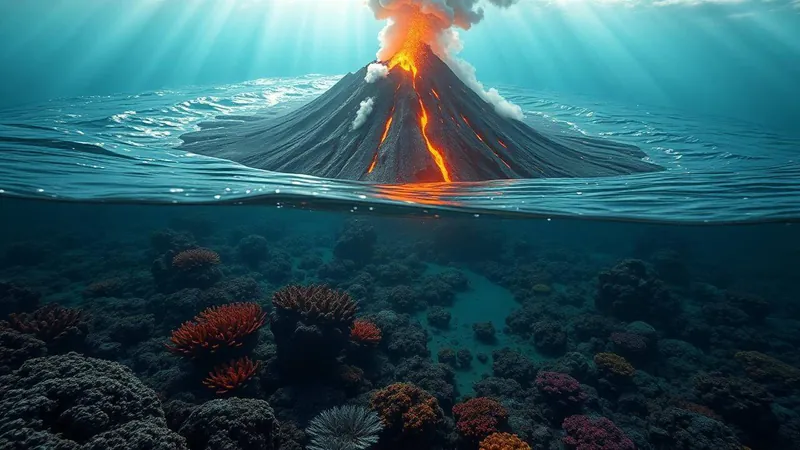
Oregon's Underwater Volcano Is Showing Signs of Eruption: What You Need to Know!
2025-05-09
Author: Liam
Axial Seamount Rumbles Back to Life!
Excitement is brewing beneath the waves off the Oregon coast, as Axial Seamount, an underwater volcano 300 miles offshore, is starting to rumble once again! Scientists are on high alert, predicting that this geological giant could erupt before the year comes to a close.
Seismic Shifts and Rising Threats
Recent seismic activity has been off the charts, with over 1,000 earthquakes detected daily in late March and early April. Bill Chadwick, a volcanologist at Oregon State University, emphasizes the warning signs: "The seafloor is actually rising, and that’s a big signal." This swelling indicates that magma is gathering beneath the volcano's surface, a classic precursor to an eruption.
A Hotspot for Volcanic Activity
Situated at a geological hotspot and along the tectonic boundary of the Pacific and Juan de Fuca plates, Axial Seamount is continuously monitored using a sophisticated network of seafloor sensors. Experts explain that this region is a hotspot for volcanic activity, where tectonic plates are pulling apart, leading to pressure buildups and magma flows.
No Immediate Danger to Humans — For Now
Despite the stirring activity, researchers assure that there is little risk to human life. Chadwick noted, "Even if you were right above the seamount when it erupts, you probably wouldn't even know it." Its remote location and the depth of the ocean mean that coastal communities and marine traffic are unlikely to be affected.
An Unpredictable Timeframe
Marine geophysicist William Wilcock at the University of Washington warned of the volcano's unpredictability, stating, "I would predict it could erupt sometime later this year or early 2026, but it could also happen tomorrow." Axial Seamount has erupted in the past, notably in 1998, 2011, and 2015, with its last event covering 25 miles of seafloor in volcanic lava.
Ecosystems Thrive Amidst Volcanic Chaos
Interestingly, the caldera formed by previous eruptions serves as a vibrant hub for unique deep-sea life. Hydrothermal vents release mineral-rich fluids, supporting a diverse ecosystem that can rapidly recover even after devastation from lava flows.
A Natural Laboratory for Scientists
While predicting eruptions remains a complex task, Axial Seamount offers an incredible opportunity for scientists to enhance their forecasting models without the risk to human life. Scott Nooner from the University of North Carolina Wilmington highlighted this unique aspect, stating, "We don’t have to worry about the human cost if we’re wrong, making it ideal for testing predictions."
Seasonal Patterns and Lunar Influences
Interestingly, all three past eruptions occurred between January and April, a time when the Earth moves away from the sun. Researchers speculate that gravitational forces from the moon could influence the timing, with ocean tides exerting fluctuating pressures on the volcanic structure.
A Groundbreaking Live Event
In an exciting scientific endeavor, the Regional Cabled Array observatory hopes to livestream the next eruption, marking a historic moment in seafloor volcanology. While the eruption may go unnoticed from the shore, it promises to provide invaluable insights into the Earth's inner workings.
Stay tuned as the ocean depths continue to stir! With scientists keeping a close watch, we might just witness this spectacular force of nature in action.









 Brasil (PT)
Brasil (PT)
 Canada (EN)
Canada (EN)
 Chile (ES)
Chile (ES)
 Česko (CS)
Česko (CS)
 대한민국 (KO)
대한민국 (KO)
 España (ES)
España (ES)
 France (FR)
France (FR)
 Hong Kong (EN)
Hong Kong (EN)
 Italia (IT)
Italia (IT)
 日本 (JA)
日本 (JA)
 Magyarország (HU)
Magyarország (HU)
 Norge (NO)
Norge (NO)
 Polska (PL)
Polska (PL)
 Schweiz (DE)
Schweiz (DE)
 Singapore (EN)
Singapore (EN)
 Sverige (SV)
Sverige (SV)
 Suomi (FI)
Suomi (FI)
 Türkiye (TR)
Türkiye (TR)
 الإمارات العربية المتحدة (AR)
الإمارات العربية المتحدة (AR)